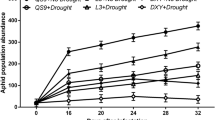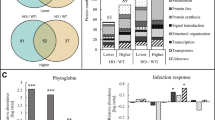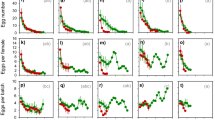Abstract
The genetic engineering of crop plants for specific desired characters is of potential importance in agriculture1. Serious consideration must therefore be given to undesirable side effects of particular modifications. The soluble nitrogen content of leaves is important in the relationship between plants and their insect predators and increases during periods of environmental stress2,3. Soluble proline increases markedly during water stress in a wide range of plant species including barley4,5 and it has been suggested that plants selected for higher proline content may be more tolerant of drought stress6. However, proline is phagostimulatory to locusts when presented on an inert matrix7 and this work has been extended by Haglund8 to suggest that proline (or valine) may be a cue detected by grasshoppers to lead them to drought-stressed nitrogen-enriched plants. Plants selected for a higher content of free proline in an attempt to increase their tolerance of drought stress might therefore prove more attractive to insect predators. To test this hypothesis we have now compared the responses of locusts, slugs, aphids and a mildew fungus to normal barley and a barley mutant9 which has up to six times the normal content of free proline in the leaves. We find no evidence that the mutant is more susceptible than its parent to damage by any of these organisms.
This is a preview of subscription content, access via your institution
Access options
Subscribe to this journal
Receive 51 print issues and online access
$199.00 per year
only $3.90 per issue
Buy this article
- Purchase on Springer Link
- Instant access to full article PDF
Prices may be subject to local taxes which are calculated during checkout
Similar content being viewed by others
References
Day, P. R. Trends biochem. Sci. 6, 1–2 (1981).
McNeil, S. & Southwood, T. R. E. Biochemical Aspects of Plant and Animal Coevolution (ed. Harbone, J. B.) 77–98 (Academic, London, 1978).
White, T. C. R. Oecologia, Berl. 22, 119–134 (1976).
Stewart, G. R. & Larher, F. The Biochemistry of Plants Vol. 5 (ed. Miflin, B. J.) 609–635 (Academic, New York, 1980).
Singh, T. N. et al. Aust. J. biol. Sci. 26, 65–76 (1973).
Singh, T. N. et al. Nature new Biol. 236, 188–190 (1972).
Cook, A. G. Ecol. Ent. 2, 113–121 (1977).
Haglund, B. M. Nature 288, 697–698 (1980).
Kueh, J. S. H. & Bright, S. W. J. Planta 153, 166–171 (1981).
Uhazy, L. S. et al. Science 201, 924–926 (1978).
Graham-Bryce, I. J. et al. J. R. agric. Soc. Engl. 140, 131–139 (1979).
Van Emden, H. F. Symp. R. ent. Soc., London (1972).
McKinlay, K. S. Can. Ent. 113, 5–8 (1981).
Bernays, E. A. et al. Bull. ent. Res. 64, 413–420 (1974).
Wyn Jones, R. G. & Storey, R. Aust. J. Pl. Physiol. 5, 817–829 (1978).
Stewart, C. R. Pl. Physiol. 66, 230–233 (1980).
Bates, L. S. et al. Pl. Soil 39, 205–207 (1973).
Hollomon, D. W. Crop Protection Agents: Their Biological Evaluation (ed. McFarlane, N. R.) 505–515 (Academic, New York, 1972).
Author information
Authors and Affiliations
Rights and permissions
About this article
Cite this article
Bright, S., Lea, P., Kueh, J. et al. Proline content does not influence pest and disease susceptibility of barley. Nature 295, 592–593 (1982). https://doi.org/10.1038/295592a0
Received:
Accepted:
Issue Date:
DOI: https://doi.org/10.1038/295592a0
This article is cited by
Comments
By submitting a comment you agree to abide by our Terms and Community Guidelines. If you find something abusive or that does not comply with our terms or guidelines please flag it as inappropriate.



